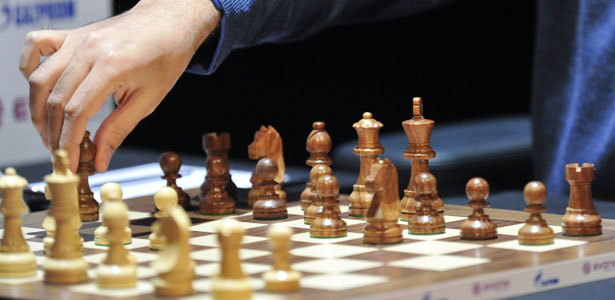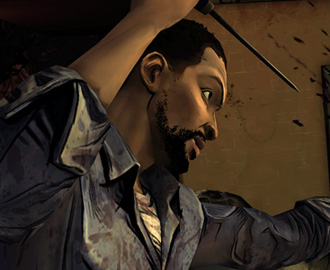How America Forgot About Chess
The once-popular game is suffering from boring grandmasters and controversial leadership.

Shortly after 2 p.m. on August 8, 1972, WNET/Channel 13 in the New York metropolitan area was swamped with phone calls protesting the station's programming. Irate viewers repeatedly asked the television producers to drop the coverage of the Democratic National Committee meeting in Washington so that they could resume watching the play-by play of a World Chess Championship game. In the midst of the presidential campaign that would see Nixon reelected, the American public preferred to watch the hours-long chess games between Bobby Fischer and Boris Spassky.
For many American chess enthusiasts, Fischer's time remains unparalleled. Never before or since his meteoric rise has chess managed to attract such a large audience in the United States. The 1972 PBS broadcast of the Fischer-Spassky games is still the most popular television chess show in history. After the celebrated match, the coverage of this ancient game has slowly disappeared from the country's mainstream media. In 1972, the national edition of the New York Times, the major newspaper that most consistently deals with chess coverage, published 241 articles that dealt specifically with the game. That number decreased to 148 in 1995, the year when Garry Kasparov, arguably the best chess player in history, squared off against Viswanathan Anand, an Indian grandmaster, on the 107th floor of the World Trade Center. The number fell further to 28 in 2011, the year when Hikaru Nakamura, an American grandmaster who right now is the seventh best player in the world, won the Tata Steel Chess Tournament, one of Europe's most recognized events.
Today, Anand, the current world champion, plays Boris Gelfand, an Israeli grandmaster, in the first game of the World Chess Federation (commonly known as FIDE for its French acronym) championship match in Moscow. While in India Anand is a national figure and in parts of Europe both players are relatively well-recognized, in the United States they are virtually unknown outside chess clubs or circles of enthusiasts. In part because of this, no one in America seems to be paying much attention to the title that once represented one of the Cold War's many battlefields. Chess has seemingly lost its cultural significance, abdicating its once revered spot to games like poker.
MORE ON GAMES
There are a variety of reasons for America's abandonment of the higher spheres of chess, according to professional players and long-time followers of the game. The absence of interesting stories and charismatic players in the past few years, along with FIDE's political and financial problems have all played a part in what at first glance looks like chess's march to oblivion.
The lack of a compelling story to fit the most important matches is one of the main drawbacks that contemporary chess has faced, according to Dirk Jan ten Geuzendam, the author of Finding Bobby Fischer and the editor of New In Chess magazine. "What we are lacking now is some conflict that makes certain players or matches attractive to broader audiences," he said shortly before traveling to Moscow. The Fischer and Spassky matches between 1960 and 1972, for instance, were framed by the Cold War, while the famous rivalry between Kasparov and Anatoly Karpov in 1980s and 1990s was seen as a clash between the old and the new guard of the crumbling Soviet Union. In both cases, the games surpassed the chess board and took on a significance that even people who had never played the game could relate to.
"Apart from that," Geuzendam added, "Fischer and Kasparov were much bigger personalities than the relatively modest Anand, who will rarely say things that will stir controversy." In chess's heyday, players, like boxers, would criticize their opponents before a match, offering demeaning remarks both to wage psychological war and to spike the public's general interest. Fischer, who would eventually become notorious for his anti-Semitic rants and conspiracy theories, ventured Muhammad Ali-like predictions about upcoming tournaments starting when he was a teenager. Kasparov, on the other hand, used his position as world champion to voice his political opinions regarding FIDE and the Kremlin. Statements from both men were picked up by the mainstream media, drawing attention to themselves and to the chess matches or tournaments they were playing. Anand, who became world champion in 2007, is a less polarizing and appealing figure, according to Geuzendam. He is a quiet 42-year-old who, unlike Kasparov, does not indulge in self-promotion or travel with vast entourages. A married man who had a child last year, Anand is consistenly described as a humble and calm man. A similar statement can be made about Gelfand, a passive man whose presence in the world championship has been surprising, given that he is currently ranked No. 20 in the world (Anand is No.4). Gelfand, 43, has had a long career in which he has barely caught the media's attention, either through tournament results or through his infrequent interviews.
Anand's charisma aside, FIDE itself has also been one of the major obstacles to chess's continued success. For years, accusations of corruption and vote-rigging have been fairly common within the organization. In fact, from the time of its inception in 1924, both internal and international politics have been a problem within the governing body. East - West rivalries led to several breakdowns during the Cold War. The complaints reached a climax in 1962 when Fischer objected to FIDE's tournament structure, arguing that the arrangements benefited the players of the Soviet Union. Another major crisis took place in 1993 when Kasparov, then the reigning world champion, broke off with the organization to create a (short-lived) parallel group called the Professional Chess Association.
Because of this rift, for more than a decade there were two reigning world chess champions, each promoted by a different group. Until Kasparov's retirement in 2005, there were several failed attempts at reunification, which each party blamed on the other's obdurate position. In 2006, the title was finally unified again under the management of FIDE's president Kirsan Ilyumzhinov, a Russian millionaire and politician whose actions as head of the World Chess Federation have been a somewhat disguised curse for the game.
From 1993 to 2010, Ilyumzhinov was the president of the Republic of Kalmykia, an autonomous Russian state that at times seems to be the spearhead of disreputable foreign policy. Since he became FIDE's president in 1995, Ilyumzhinov visited Saddam Hussein, Muammar Gaddafi, and, almost a week ago, Bashar al-Assad. Though most of his visits were not chess-related, Ilyumzhinov's activities often tarnish the game and occasionally tread a dangerous path that mixes FIDE with politics. While Saddam Hussein was still in power, for instance, Ilyumzhinov scheduled a world championship match in Baghdad (he eventually moved the match to his country's capital, Elista, to quell the international outrage).
Up to a certain point, Ilyumzhinov's and FIDE's political debacles have shifted the attention from chess to the muddled inner dealings of the organization. "In the past years, it really didn't help that the World Chess Federation was making a mess of organized chess," Geuzendam said. "There were many things there that made a lot of harm," he concluded referring to the impact on the professional circuit.
The damage is not permanent, though, and many commentators believe that chess will make a comeback in America. Daniel Lucas, Director of Publications of the US Chess Federation and Editor of Chess Life magazine, says that a rebirth is gradually underway. "U.S. Chess Federation members have remained flat for the last couple of years, but they are showing a slight uptick now," he said. While Kasparov defended his title and staged matches against computers like IBM's Deep Blue in the 1990s, the number of members rose from around 53,000 to almost 85,000 in 2000. The numbers then fell steadily to well under 80,000, and they recently rose to 79,000.
For Lucas and many other chess professionals, Magnus Carlsen, the No. 1 player in the world, might be the answer to Anand's meekness. Carlsen, a 21-year-old Norwegian grandmaster who has trained with Kasparov and is already one of the strongest players in history, has two corporate sponsors and has been a guest on shows like 60 Minutes and the Colbert Report. He has been compared to Justin Bieber and he has modeled for G-Star, a Dutch clothing company. "Carlsen with his modeling work, and being one of the youngest top players ever is something that the mainstream media can really bite into," Lucas says.
In America, the hopes for a new world championship rest on Hikaru Nakamura, a young Japanese-born chess prodigy who became a grandmaster when he was 15 years old. Jennifer Shahade, a woman grandmaster who edits Chess Life Online, says Nakamura "is very charismatic and I think he has the potential to win the world championship. If he did that would be incredible for the game."
To become world champion, Nakamura will have to square off against players like Carlsen, Levon Aronian, the world No. 2 and another man who is often described as potentially appealing to the general audience, and finally against the winner between Anand and Gelfand, two members of the old guard. "They are very imaginative players," Geuzendam said of the younger generation. "I don't see why they couldn't bring about a new heyday for chess."




